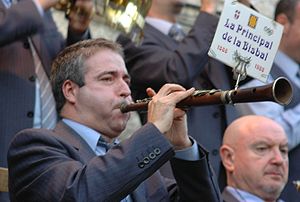
Catalan shawms
Encyclopedia

Shawm
The shawm was a medieval and Renaissance musical instrument of the woodwind family made in Europe from the 12th century until the 17th century. It was developed from the oriental zurna and is the predecessor of the modern oboe. The body of the shawm was usually turned from a single piece of wood,...
(an oboe
Oboe
The oboe is a double reed musical instrument of the woodwind family. In English, prior to 1770, the instrument was called "hautbois" , "hoboy", or "French hoboy". The spelling "oboe" was adopted into English ca...
-like woodwind instrument) played in Catalonia
Catalonia
Catalonia is an autonomous community in northeastern Spain, with the official status of a "nationality" of Spain. Catalonia comprises four provinces: Barcelona, Girona, Lleida, and Tarragona. Its capital and largest city is Barcelona. Catalonia covers an area of 32,114 km² and has an...
in northeastern Spain.
Region, types, and uses
The types of shawm commonly used in Catalonia are the tible (ˈtibːɫə, CatalanCatalan language
Catalan is a Romance language, the national and only official language of Andorra and a co-official language in the Spanish autonomous communities of Catalonia, the Balearic Islands and Valencian Community, where it is known as Valencian , as well as in the city of Alghero, on the Italian island...
for "treble") and the tenora (təˈnoɾə, Catalan for "tenor"). The tenora is pitched about a fifth lower than the tible. These shawms are usually used with other instruments to accompany the traditional Catalan circle dance, the Sardana
Sardana
The sardana is a type of circle dance typical of Catalonia, Spain. The dance was originally from the Empordà region, but started gaining popularity throughout Catalonia during the 20th century....
. Other Catalan folk shawms are the tarota (təˈɾɔtə) the original keyless version of the tible, and the gralla (ˈgɾaʎə), a short, strident instrument with a steep conical bore. Both of these resemble shawms from other parts of Spain, such as the dolçaina
Dulzaina
The dulzaina or dolçaina is a Spanish double reed instrument in the oboe family. It has a conical shape and is the equivalent of the Breton bombarde....
of Aragon and Valencia, and both employ open fingering.
Difference between shawms and oboes
There are several distinct differences between shawms and oboeOboe
The oboe is a double reed musical instrument of the woodwind family. In English, prior to 1770, the instrument was called "hautbois" , "hoboy", or "French hoboy". The spelling "oboe" was adopted into English ca...
s. Shawms normally have a larger bore, which makes them louder and more suitable than the oboe for outdoor playing. In addition, the bore is more "sword-shaped" than that of the oboe (it is more like a narrow parabola than a perfect cone). This gives the shawm a stronger, earthier, more fiery tone. Though favored in ancient times, some today find the sound harsh and irritating. The difference in bore shape also gives shawms additional problems with intonation
Intonation (music)
Intonation, in music, is a musician's realization of pitch accuracy, or the pitch accuracy of a musical instrument. Intonation may be flat, sharp, or both, successively or simultaneously.-Interval, melody, and harmony:...
. It was the goals of easier fingering, better intonation, and a sound and volume level more suitable for indoor use that prompted the innovations that turned the shawm into the oboe. The tible and tenora, however, were modernized without giving up their place in bands and at festivals, and they retained the basic shawm characteristics. One unique characteristic of shawms is that, unlike oboes, they are made of one solid piece of wood. Also, the wide, flaring bell is often rimmed with metal (or at least used to be in Europe). This made the shawms very durable.
Catalan shawms and other types of shawms
There are many shawms throughout the world (many of them in the Middle East and Asia) but Catalonia is one of the few places in Europe where they are still frequently used, and the only place where they have been given a modern mechanism (keywork) like orchestral woodwind instruments. Shawms used to be widespread in Europe up into the RenaissanceRenaissance
The Renaissance was a cultural movement that spanned roughly the 14th to the 17th century, beginning in Italy in the Late Middle Ages and later spreading to the rest of Europe. The term is also used more loosely to refer to the historical era, but since the changes of the Renaissance were not...
. They were chiefly of two types: shawms that evolved from bagpipe chanters, and shawms that evolved from Middle Eastern instruments. The Italian ciaramella is an example of the former, and the tible and tenora of the latter. The oboe features aspects of both designs.
Source and additional information
- Woodwind Instruments and Their History by Anthony BainesAnthony BainesAnthony Cuthbert Baines was an English organologist who produced a wide variety of works on the history of musical instruments, and was a founding member of the Galpin Society.-Partial bibliography:...
.

